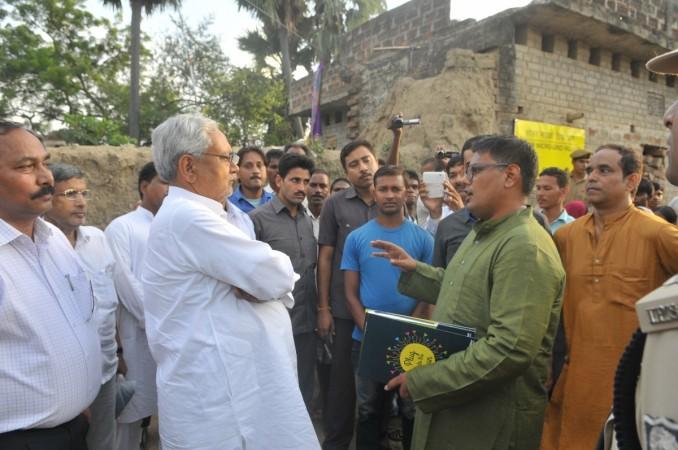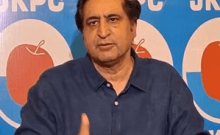
Former chief minister Nitish Kumar on Monday visited Dharnai in Jehanabad district of Bihar, India's first fully solar-powered village, and praised the Greenpeace's efforts in installing the micro-grid.
Kumar, elated with the unique energy model, upheld it as a crucial step towards rural electrification of Bihar. The micro-grid is now powering the homes, shops, schools and street-lights of Dharnai.
"Solar energy is the only solution and I praise and appreciate Greenpeace for accepting the challenge in successfully installing this everlasting viable solution model," Kumar told the 2,000 people gathered for the public event in Dharnai on 4 August.
On 16 May 2012, Kumar, then chief minister of Bihar, had suggested that Greenpeace should display viability of a clean energy micro-grid through a pilot project that his government would then replicate throughout the state.
"Billion units of electricity are produced in this country everyday but it never reaches the villages and towns of poor states like Bihar because they are not connected to the country's energy infrastructure or the national grid," Manish Ram, Senior Campaigner, Renewable Energy, Greenpeace India, had said.
To stop this energy injustice, Greenpeace had advocated to the Bihar government that it must not depend on Central power supply, but produce its own electricity at smaller, village-levels using clean energy," he added.
Speaking at the function, Dr Shaibal Gupta, Secretary of Asian Development Research Institute, commented, "It is very encouraging to see that Greenpeace has successfully demonstrated the viability of renewable energy by setting up a micro-grid that provides clean power to an entire village. This will definitely play a vital role in transforming the energy sector of Bihar."
Built at a cost of ₹3 crore, the 100kW micro-grid in Dharnai provides electricity round-the-clock to 450 households, 50 commercial establishments, 60 street-lights, two schools, one health centre and one Kisan Training Centre. Besides this, 10 solar irrigation pumps also run on the micro-grid.
Greenpeace reiterates that Bihar, being home to one of India's most fertile lands and a large labour force, has the potential to become the country's next centre of agricultural and industrial growth. However, lack of electricity continues to remain a critical issue, posing as an impediment in the growth of Bihar.
But with Nitish Kumar's latest visit to Dharnai, the state government has reaffirmed its commitment and willingness to adopt models that can quickly overcome Bihar's severe energy crunch.
"We must appreciate Greenpeace's effort to safeguard our environment. We are destroying our environment and we usually are unaware about it... Solar is the real energy as it is non-depleting and is here to stay" Kumar said.
"We hope that after witnessing the merit of this project, the state government would fulfill its promise of replicating Dharnai-like models across the state and deliver power to all those who are currently living without it," added Ram.
The story of Dharnai has not just impressed Nitish Kumar, it has received traction among supporters of renewable energy worldwide.
Well done to the villagers of Dharnai and to Greenpeace India as micro-grid solar changes their lives http://t.co/aKhh4YzknR
— Julie-Anne Richards (@jar_climate) July 28, 2014
dishonest to harass @greenpeaceindia when they have proven how much value they add to the people the Govt ignores - http://t.co/YnOcPSZkz4 — Aliya Curmally (@filminista) July 31, 2014
India's first solar village powers up http://t.co/WUj7BPzyk7
— Tom Dowdall (@TominAms) August 4, 2014
"@Greenpeace #Dharnai is now known as the village where the sun doesn't set. Discover more ... http://t.co/x4nvFhMRga — julietteleifc (@julietteleifc) July 28, 2014
A Timeline of the Micro-Grid Project– From Darkness to Light in Two Years
| 15 May 2012 | Brijendra Prasad Yadav, then Bihar energy minister, releases Greenpeace's "Energy Revolution Bihar – The Renewable Energy Way" report demonstrating the potential and viability of decentralised renewable energy or distributed micro-grids in Bihar. |
| 16 May 2012 | Nitish Kumar meets Greenpeace representatives. Asks for setting up of a pilot micro-grid that can be replicated across Bihar. |
| 18 May 2012 | Then chief minister Nitish Kumar holds a high-level meeting with his cabinet. Says the energy requirements of Bihar can be fulfilled only through renewable energy like biomass, husk and solar. |
| 23 September 2013 | Greenpeace presents Bihar government with a report on legal, policy and regulatory framework required to accelerate renewable energy development in Bihar. |
| 18 October 2013 | Following on Nitish Kumar's initiation, Greenpeace lays the foundation stone for setting up of micro-grid at Dharnai village in Jehanabad district. |
| 12 March 2013 | Micro-grid work completes. Begins supplying electricity to village. |
| 20 July 2013 | Greenpeace officially launches micro-grid in the presence of over 3,000 villagers and activists. |

















